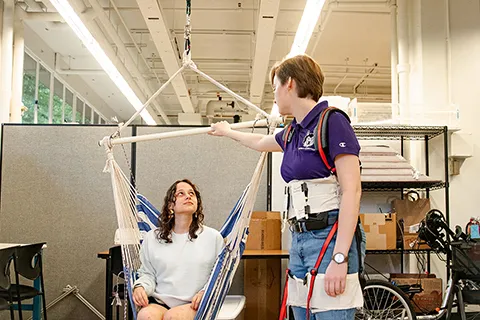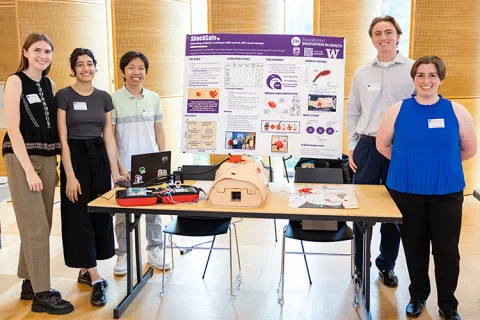Pacific Northwest National Laboratory (PNNL)
Through-Ice Energy Harvester Deployment Mechanism
Generating electrical power from currents and waves may enable ocean sensing in energy-constrained environments like high latitudes where other renewable sources like solar may not be practical or viable. One area of interest is powering sensors fixed to sea ice, which is critical for understanding the warming arctic. To power such sensors, devices are being investigated that can harvest the energy from the relative motion between floating sea ice and water, such as small turbines or vortex-induced-vibration elements. A key design challenge for these devices is how the harvesting system accesses the ice/water interface underneath the sea ice and secures itself there, particularly on ice too hazardous to safely support access by personnel. The student team worked to develop conceptual solutions and a prototype design of an automated deployment and securement mechanism for a current energy harvester below the ice that can position and secure an energy harvesting system under floating sea ice from a starting position at the ice surface and facilitate electrical connectivity from the harvester to sensors at the ice surface. The system is equipped with enough energy to complete its task and self-deploy with no additional human intervention and is expected to survive through a full season of ice breakup and melting.
Faculty Adviser
Eli Patten,
ME Capstone Director,
Mechanical Engineering
Students
Bailey Deck
Cole Nichols
Garrett Larson
Griffey Sarmiento
Yoeur-Man Teagan Mach
Related News

Fri, 09/20/2024 | UW Civil & Environmental Engineering
Smarter irrigation for a greener UW
A new project combines satellite data with ground sensors to conserve water and create a more sustainable campus environment.

Mon, 09/09/2024 | UW Mechanical Engineering
Testing an in-home mobility system
Through innovative capstone projects, engineering students worked with community members on an adaptable mobility system.

Mon, 08/19/2024 | UW Mechanical Engineering
Students strive to ensure accurate AED shock dosage
ShockSafe, developed by students with the help of mentors from Philips and Engineering Innovation in Health (EIH), can distinguish between children and adults during cardiac arrest emergencies.

Wed, 08/07/2024 | Snohomish County News
Snohomish County, University of Washington partnership boosts efficiency in enterprise scanning center
UW Industrial and Systems Engineering Capstone Project set to save Snohomish County over $40,000 annually.